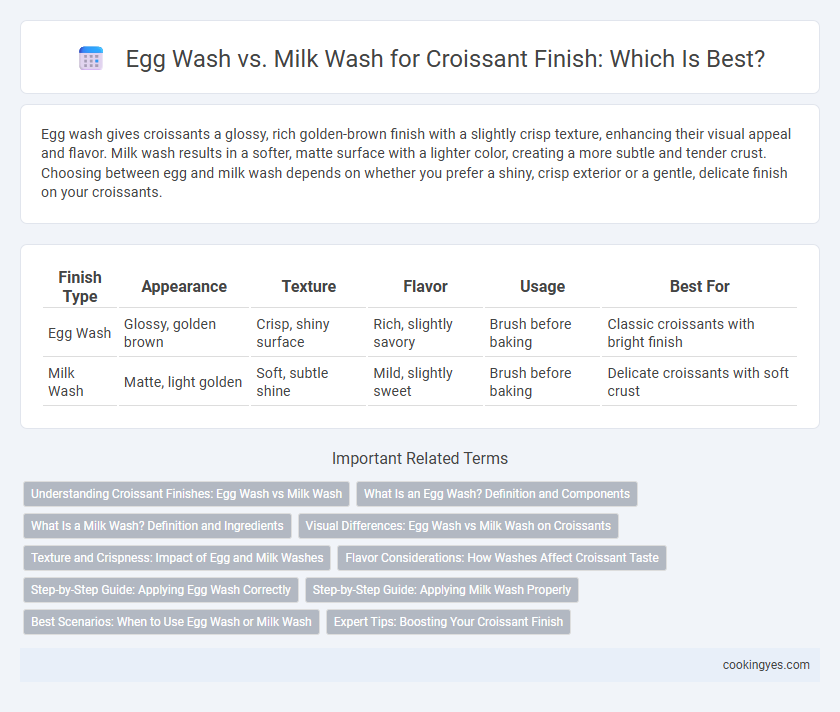Egg wash gives croissants a glossy, rich golden-brown finish with a slightly crisp texture, enhancing their visual appeal and flavor. Milk wash results in a softer, matte surface with a lighter color, creating a more subtle and tender crust. Choosing between egg and milk wash depends on whether you prefer a shiny, crisp exterior or a gentle, delicate finish on your croissants.
Table of Comparison
| Finish Type | Appearance | Texture | Flavor | Usage | Best For |
|---|---|---|---|---|---|
| Egg Wash | Glossy, golden brown | Crisp, shiny surface | Rich, slightly savory | Brush before baking | Classic croissants with bright finish |
| Milk Wash | Matte, light golden | Soft, subtle shine | Mild, slightly sweet | Brush before baking | Delicate croissants with soft crust |
Understanding Croissant Finishes: Egg Wash vs Milk Wash
Egg wash creates a glossy, deep golden-brown finish on croissants, enhancing visual appeal and providing a slightly crisp texture. Milk wash results in a softer, matte surface with a tender crumb, offering a more subtle color and finish. Choosing between egg wash and milk wash depends on the desired croissant appearance and texture, with egg wash favored for shine and milk wash for a delicate look.
What Is an Egg Wash? Definition and Components
An egg wash is a mixture typically made from beaten eggs, sometimes combined with water or milk, used to coat croissant dough before baking to achieve a glossy, golden-brown finish. The protein and fat in the egg help create a shiny and slightly crisp crust, enhancing both appearance and texture. Variations in the egg wash composition, such as using whole eggs, egg yolks, or whites, influence the final color and sheen of the croissant.
What Is a Milk Wash? Definition and Ingredients
A milk wash for croissants is a brushing technique that uses milk to create a soft, golden-brown crust with a subtle shine. Typically made from whole milk or a combination of milk and water, this wash adds moisture and enhances browning through lactose and proteins. Unlike egg wash, milk wash produces a gently glossy finish without the intense shine or richness, ideal for a tender, less crispy croissant crust.
Visual Differences: Egg Wash vs Milk Wash on Croissants
Egg wash on croissants creates a glossy, deep golden-brown finish with a slightly crisp texture, enhancing visual appeal and highlighting the flaky layers. Milk wash results in a softer, matte sheen with a lighter golden color, producing a more delicate surface appearance. The choice between egg wash and milk wash significantly influences the croissant's final look, affecting both color intensity and surface texture.
Texture and Crispness: Impact of Egg and Milk Washes
Egg wash adds a rich golden shine and promotes a crispier, flakier crust on croissants due to its protein content, which enhances browning through the Maillard reaction. Milk wash contributes to a softer, more matte finish with less crispness, as the milk sugars caramelize gently without creating a hard crust. Choosing between egg and milk wash directly affects the croissant's texture, with egg wash favoring a firmer, crisp exterior and milk wash resulting in a tender, less crunchy surface.
Flavor Considerations: How Washes Affect Croissant Taste
Egg wash enhances croissant flavor by adding a rich, savory note and deep golden color due to its protein content caramelizing during baking. Milk wash imparts a subtle sweetness and tender crust, resulting from the lactose in milk that helps develop a softer texture. Choosing between egg wash and milk wash influences the croissant's final taste profile, balancing between a bolder savoriness and a gentle, creamy flavor.
Step-by-Step Guide: Applying Egg Wash Correctly
Applying an egg wash to croissants enhances their golden-brown color and adds a glossy finish, creating a visually appealing crust. Begin by whisking one egg with a tablespoon of water or milk until smooth, then use a pastry brush to evenly coat the croissant surface before baking. For optimal results, apply the egg wash in a gentle, even layer without saturating the dough, avoiding pooling that can cause uneven browning or sogginess.
Step-by-Step Guide: Applying Milk Wash Properly
Applying milk wash on croissants involves brushing the surface gently with cold milk before baking to achieve a soft, golden-brown finish with a delicate sheen. Unlike egg wash, which creates a glossy and darker crust, milk wash provides a subtle, matte look while contributing to a tender texture. For best results, use a clean pastry brush and apply an even, thin layer of milk to avoid sogginess and ensure an appealing, uniform color.
Best Scenarios: When to Use Egg Wash or Milk Wash
Egg wash creates a glossy, golden-brown finish on croissants, making it ideal for pastries needing a shiny, rich appearance, such as those filled with chocolate or almond paste. Milk wash provides a softer, matte finish with a light browning effect, perfect for croissants where a more subtle crust is desired, like plain or butter croissants. Choosing egg wash enhances visual appeal and texture, while milk wash maintains tenderness and a delicate look.
Expert Tips: Boosting Your Croissant Finish
Egg wash creates a shiny, golden-brown finish on croissants by promoting Maillard reaction, enhancing both color and texture. Milk wash, rich in proteins and sugars, contributes to a softer crust with a subtle sheen while adding slight sweetness. Experts recommend using egg wash for a classic, crisp exterior and milk wash when aiming for a tender, lightly glossy finish.
Egg wash vs milk wash for croissant finish Infographic

 cookingyes.com
cookingyes.com